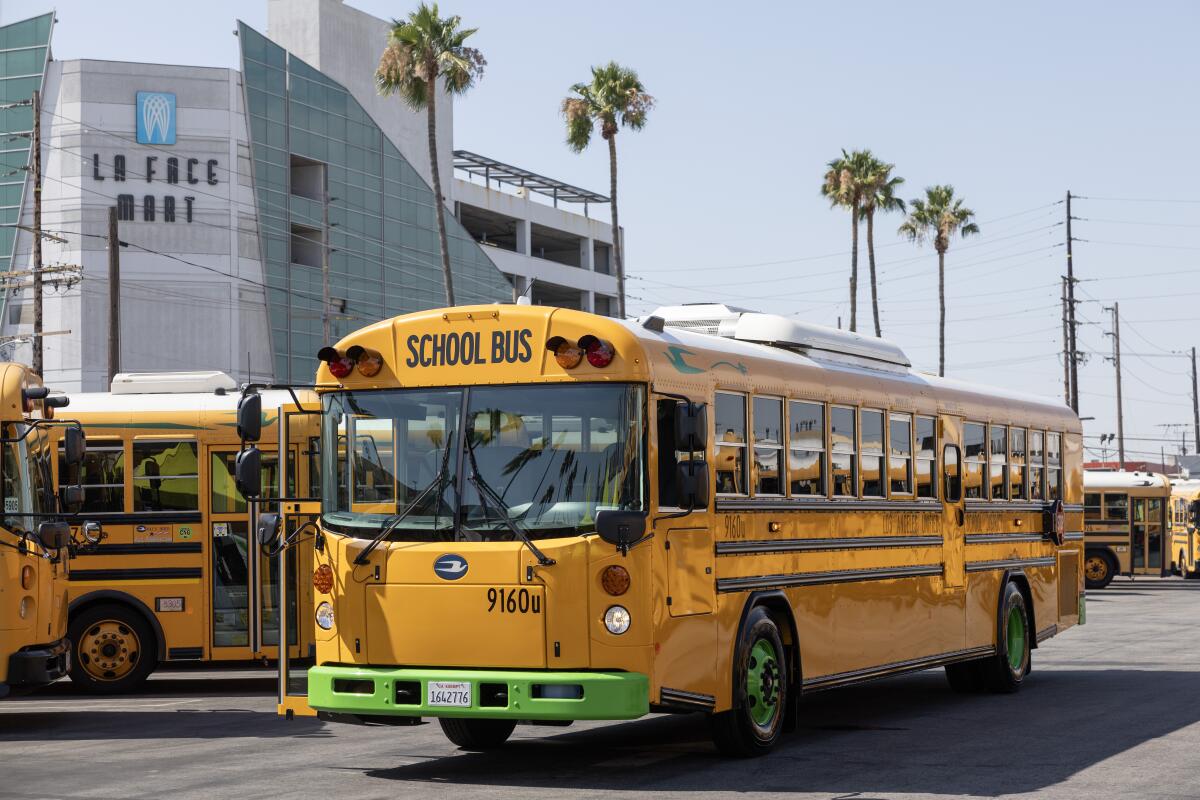LAUSD puts $9 billion in bonds on ballot that would update campuses and raise property taxes

- Share via
The Los Angeles Board of Education on Wednesday voted unanimously to put a $9-billion school construction bond on the ballot in November — the largest in district history and comparable in size to the $10-billion statewide school bond measure that is already going before voters.
If approved by at least 55% of voters, the L.A. Unified School District bond would raise property taxes for the median-priced home about $273 a year, according to estimates by the Howard Jarvis Taxpayers Assn. A district spokesperson put the median impact at closer to $100, saying the fee would be based on a home’s assessed value, not the market value.
The overall rate of taxation will be $25 per year for every $100,000 of assessed valuation, adding to a property tax bill that already contains fees for other purposes, including for the repayment of earlier school bonds.
“The time is now,” said L.A. schools Supt. Alberto Carvalho during Wednesday’s specially called meeting. “I know this is a tough question. It is never an easy one, but what we do defines who we are.”
What makes the question tougher is that L.A. Unified is asking for more facilities funding amid steadily declining enrollment — a trend that experts say will ultimately lead to the closing of campuses, including those that are part of the bond spending plan.
The $9 billion amount is “not too much,” Carvalho said, in the context of a calculated need of $80 billion, alluding to a district estimate.
The benefits and costs of these bonds apply only to areas within the boundaries of the Los Angeles Unified School District. That includes the city of L.A., as well as all or part of some two dozen smaller cities, including Bell, Maywood, South Gate and San Fernando.
At Wednesday’s meeting nearly all public speakers strongly supported the bond, although some objected to particulars.
The Howard Jarvis Taxpayers Assn. opposes the bond.
“At a time when Los Angeles homeowners are struggling to pay the high cost of living, including skyrocketing utility bills, this bond would sharply increase property taxes,” said Susan Shelley, the group’s vice president for communications.
She added: “With enrollment declining, taxpayers have a right to ask that all possible cost savings be implemented before the district asks for another tax increase.”
L.A. school officials said in a staff report that the needs “are great — more than 60% of school buildings are over 50 years old and desperately in need of upgrades, which means most of Los Angeles Unified students are attending school in deteriorating and aging facilities that do not meet today’s standards for learning and safety.”
School bond supports say the money is direly needed to help fund repairs and upgrades at thousands of California public elementary, middle and high schools and community colleges.
The meeting was scheduled with 24 hours’ advance notice — the legal minimum. The board faced a Friday deadline to get the bond issue on the November ballot.
How would the bond money be used?
A summary of the initiative spoke of the need “to upgrade, modernize, and replace aging and deteriorating school facilities, including school technology infrastructure and equipment.”
Goals also include “enhancing and expanding outdoor spaces and food services for students” and promoting “energy efficiency.”
Projections call for about $5 billion for “major modernizations, upgrades and reconfigurations to school campuses.”
Other funding areas include: $75 million for electric buses; $461 million for cafeteria upgrades: $258 million to make spaces accessible for those with disabilities; $70.5 million for security cameras.
About $1.25 billion is to go toward school greening projects. These could include planting trees, removing asphalt from playgrounds, installing outdoor classrooms and erecting shade structures.
Mireya Valencia, progam director of the L.A. Neighborhood Land Trust, called for more, saying about $3 billion is needed for such efforts.
About $300 million is provisionally set aside for charter schools, which enroll about 22% of district students. That amount is too low, said Keith Dell-Aquila, an advocate with the California Charter Schools Assn. He added that the district should adjust its plans on how the money would be spent.
District officials said they had flexibility on spending decisions, but did not commit to making specific changes.
Charters are privately operated public schools that frequently make use of available space in district-operated campuses. The charter association has not taken a position on the bond.
All board members praised the upcoming bond effort. But board member Nick Melvoin said the district needs to examine its construction practices.
“Things need to be done more efficiently, more quickly, and more cheaply,” Melvoin said. “We need to work harder and we need to work better.”
A history of overcrowding
From the mid-1980s through the early 2000s, the school system coped with crowding by operating year-round — but with a calendar that reduced the number of school days for students by nearly a month. And scheduling limitations excluded many students from advanced coursework. Meanwhile, playgrounds became seas of asphalt broken up by portable classroom buildings.
In response, the school system has passed a series of bonds since the late 1990s.
High construction costs reduced the original scope of the projects, but the effort returned students to a full school year and to their neighborhood schools. This was possible in part because enrollment began to decline steadily, a trend that has continued.
New challenges in 2024
The current challenge is to repair aging campuses and modernize and improve classrooms and school buildings.
The existing construction program is not yet out of money. About $3.5 billion is assigned to projects that have been approved but not put out to bid. Another $1.8 billion is earmarked for projects that the Board of Education has yet to approve.
An example of the current wave of projects is the ongoing reconstruction of Belvedere Middle School in East Los Angeles and Roosevelt High School in Boyle Heights.
The work of the bond-funded construction also could be seen Monday at Jordan High School in Watts. Bond money had been used to build a wellness clinic that will serve the physical and mental health needs of families in a low-income community that is short on healthcare.
This clinic first opened in 2008, but the provider could not keep it going during the COVID-19 pandemic. A new provider, UMMA Community Clinic, is taking over the refurbished facility.
“What we have behind us is proof positive that what is happening in this community is still not a reality [in] many other communities,” Carvalho said at the clinic’s grand opening. “So continued investments in physical infrastructure like these wellness centers, like air conditioning units, like roofs, window replacement. All the things that we want to see in every single community continue to be a priority for our district and our school board.”
What about the state school bond?
Proposition 2 would allow the state to borrow $10 billion to help fund repairs and upgrades at school districts and community colleges.
The money from the last successful school bond, which passed in 2016, has long since been spent, and the state’s school repair fund is expected to be depleted by January. There is a wait list of districts hoping the new bond will pass so that $3.4 billion can be provided for already approved projects to take care of hazardous mold, leaky roofs and septic systems, as well as to build classrooms, modernize science labs and replace aging buildings.
If approved by a simple majority of voters, the bond would allow legislators to borrow money that would be repaid out of the state budget over time.
L.A. officials estimate that the district could be eligible for about $700 million from the state bond.
More to Read
Sign up for Essential California
The most important California stories and recommendations in your inbox every morning.
You may occasionally receive promotional content from the Los Angeles Times.












